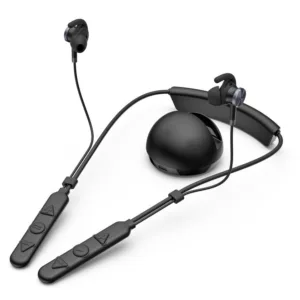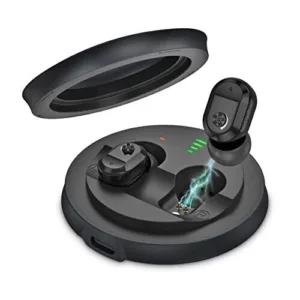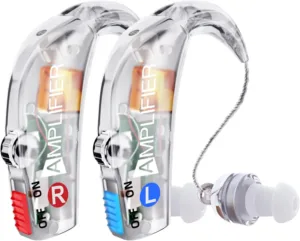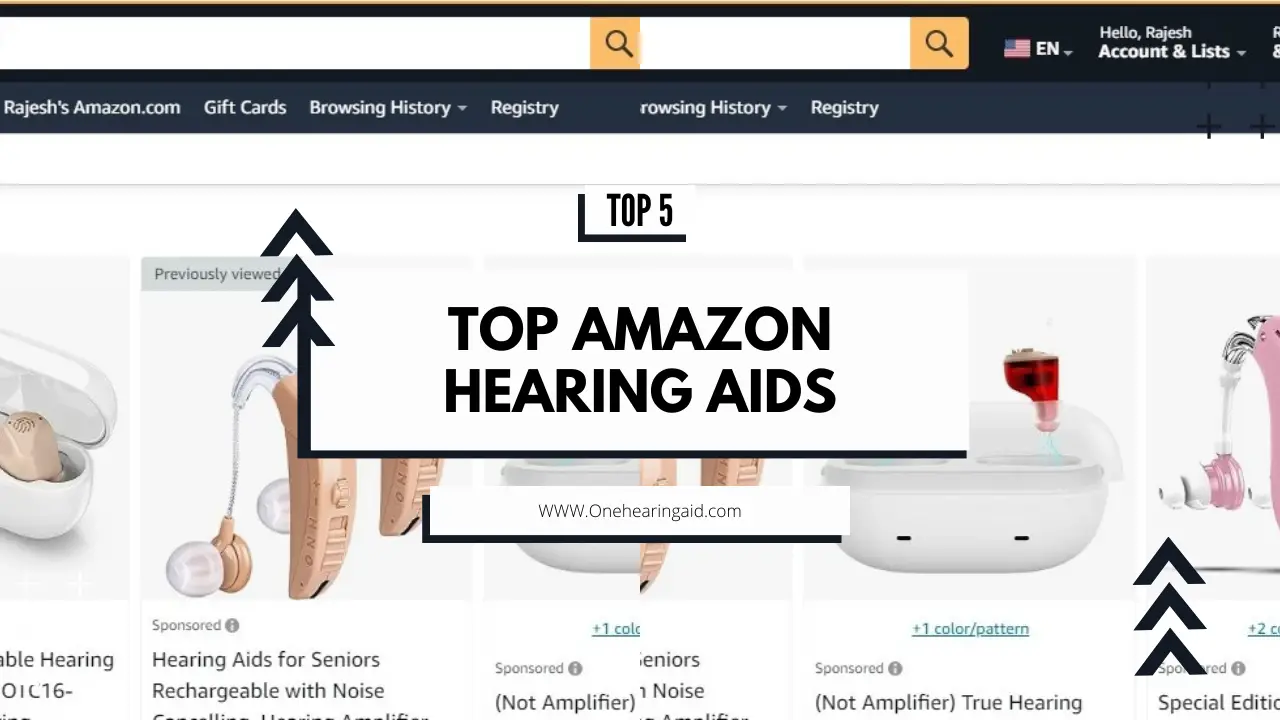Unsure if those “Top Amazon Hearing Aids” are truly for you? Dive deeper! This guide unveils the reality behind Amazon hearing aids. Explore the risks of unaddressed hearing loss, understand the difference between hearing aids and PSAPs, and discover why a professional evaluation is crucial. Learn how to navigate Amazon options cautiously and prioritize your hearing health with expert guidance.
Unveiling the Top Amazon Hearing Aids: The Heard and the Unheard
While Amazon offers a vast selection of products, venturing into the world of hearing aids online requires caution. This guide will unveil both the advertised “bestsellers” and shed light on the truth about hearing aids on Amazon.
We’ll explore:
- The Heard: Popular hearing aids listed on Amazon, understanding, however, these may not be true hearing aids but rather amplification devices.
- The Unheard: Why consulting a licensed hearing professional is crucial for proper hearing evaluation and hearing aid selection.
Decoding the Differences: Hearing Aids vs. Personal Sound Amplification Products (PSAPs)

Now, let’s delve deeper and understand the key distinctions between what you might find advertised as hearing aids on Amazon and what true hearing aids are. We’ll also explore the regulations surrounding each.
Hearing Aids:
- Medical Devices: Hearing aids are FDA-approved medical devices that require a prescription from a licensed audiologist.
- Customized Solutions: Following a hearing test, an audiologist programs hearing aids to address your specific type and degree of hearing loss. This ensures they amplify the sounds you have trouble hearing, while potentially reducing background noise for improved clarity.
- Focus on Clarity: Hearing aids not only amplify sound but also use sophisticated technology to enhance speech intelligibility and reduce background noise.
- Professional Support: Audiologists provide ongoing support and programming adjustments as your hearing needs evolve.
Personal Sound Amplification Products (PSAPs):
- Amplification Focus: PSAPs are generally unregulated consumer electronics that simply amplify all sounds.
- One-Size-Fits-All Approach: They don’t address individual hearing loss patterns and may even worsen certain sounds for people with hearing difficulties.
- Limited Functionality: PSAPs lack the advanced features of hearing aids, such as noise reduction and directional hearing.
- No Professional Guidance: There’s no medical evaluation or professional fitting involved with PSAPs.
Registration vs. Regulation:
- Hearing Aids: Hearing aids require FDA premarket approval for safety and effectiveness.
- PSAPs: PSAPs generally don’t require FDA approval, but they do need to be registered with the FDA. This registration is less stringent than premarket approval and focuses on ensuring they don’t emit harmful levels of sound.
The Autiphon U0 Series: A Closer Look (Approach with Caution)

Having explored the key differences between hearing aids and PSAPs, let’s examine the Autiphon U0 Series, a popular option on Amazon.
Advertised Features:
- Sleek Design: The U0 Series is likely designed to be discreet and comfortable.
- Advanced Features: While details might be scarce, terms like “advanced features” are often used for PSAPs.
- Impressive 50-hour Battery Life: This extended playtime is certainly appealing.
- Innovative Charging Base Redefining Convenience: A convenient charging solution is always a plus.
Important Considerations:
- Limited Information: The advertised features on Amazon may not provide enough details about how the U0 Series addresses your specific hearing loss.
- PSAP Potential: Given its availability on Amazon and the lack of mention of medical-grade functionalities, there’s a chance the U0 Series might be a PSAP rather than a true hearing aid.
- Professional Evaluation Needed: Only a licensed hearing professional can diagnose your hearing loss and determine if the U0 Series is suitable for your needs.
Recommendation:
Before considering the Autiphon U0 Series, prioritize a hearing evaluation with a licensed audiologist. They can assess your hearing loss, recommend appropriate solutions (including whether a hearing aid or PSAP is best for you), and guide you toward effective options.
Exploring HSKLOCK Hearing Aids: Similar Cautions Apply

Following our discussion on hearing aids versus PSAPs, let’s approach the HSKLOCK hearing aids with the same cautious optimism.
Advertised Features:
- Discreet Behind-the-Ear Design: This design can be comfortable and preferred for aesthetic reasons.
- Convenience of Disposable Batteries: Disposable batteries offer ease of use, but can be a recurring cost.
- Intuitive Controls Enhancing Usability: Easy-to-use controls are a plus for user experience.
Cautious Considerations:
- Limited Details on Amazon: Just like the Autiphon U0 Series, the description may not reveal how the HSKLOCK addresses specific hearing loss.
- Potential PSAP: The availability on Amazon and the lack of mention of medical-grade features suggest these might be PSAPs, not true hearing aids.
- Professional Evaluation is Key: Consulting a licensed audiologist for a hearing evaluation is crucial before considering HSKLOCK. They can properly diagnose your hearing loss and recommend the most suitable solution.
Recommendation:
Similar to the Autiphon U0 Series, prioritize a professional hearing evaluation before looking at HSKLOCK. An audiologist can provide personalized guidance and ensure you explore solutions that effectively address your hearing needs.
Immersing in Realistic Testing Scenarios: Why Hearing Aids Deserve Real-world Trials
Now that we understand the importance of professional guidance and the distinction between hearing aids and PSAPs, let’s explore the concept of testing hearing aids in realistic environments.
Beyond the Doctor’s Office:
A hearing evaluation typically occurs in a sound-controlled booth. While this is essential for initial assessment, it doesn’t replicate the complexities of everyday listening.
Testing Environments:
Imagine experiencing the following scenarios with different hearing aid options (all recommended by your audiologist):
- Quiet library: Can you hear soft-spoken conversations or whispers?
- Bustling restaurant: How well do the hearing aids handle background noise while enabling you to follow conversations at your table?
- Windy outdoors: Does wind noise become distracting or do the aids effectively reduce it?
- Kitchen with clanging pots: Can you hear important sounds like the doorbell or fire alarm while everyday noises are under control?
By trying hearing aids in various real-world settings, you’ll gain a better understanding of their effectiveness in the situations you encounter most often.
Impact on Performance:
Different environments have unique acoustic challenges. Traffic noise in a car, background music in a store, or children playing in a park can all impact how well your hearing aids perform. A trial period allows you to assess how well each option tackles these challenges and helps you select the hearing aids that best suit your lifestyle.
Working with Your Audiologist:
Discuss your typical daily activities with your audiologist. They can recommend realistic testing scenarios and guide you through the trial process to ensure you make an informed decision about your hearing health.
The Clarity Conundrum: Why Amazon Hearing Products Often Fall Short
Choosing hearing amplification is a delicate balance between boosting the sounds you need to hear and preserving overall sound quality. Here’s why Amazon-advertised devices often struggle with this challenge compared to hearing aids from licensed audiologists.
Speech Clarity and High-Frequency Amplification:
- The Importance of High Frequencies: Speech relies heavily on high-frequency sounds, like consonants (f, s, th). These are often the first to fade with hearing loss.
- Hearing Aids: Hearing aids, programmed by audiologists, amplify specifically the high frequencies you struggle with, enhancing speech intelligibility.
- PSAPs on Amazon: PSAPs often amplify all sounds equally. This might seem helpful, but it can:
- Make background noise overwhelming.
- Cause distortion, making speech sound muffled or unnatural.
- Further damage remaining high-frequency hearing.
The Clarity Comparison:
Imagine having a conversation in a crowded restaurant.
- Hearing Aid: Amplifies your friend’s voice (high frequencies) while reducing background noise, allowing for clear conversation.
- Amazon Device (PSAP): Amplifies everything, including the background music and clanging dishes. Your friend’s voice might be louder, but it’s also muffled by the amplified noise, making it difficult to understand.
Finding True Clarity:
A licensed audiologist can assess your hearing loss and program hearing aids to amplify the specific frequencies you need. This targeted approach delivers superior speech clarity without sacrificing overall sound quality.
Tailored Amplification Insights: NAL-NL2 and Beyond

The world of hearing aid technology goes beyond basic amplification. Let’s delve into a specific fitting target, NAL-NL2 1000Hz 65 dB input, to understand how hearing aids are customized for optimal performance.
Understanding NAL-NL2:
- NAL-NL2 is a prescription formula commonly used by audiologists when programming hearing aids.
- It considers several factors: including your hearing loss type and severity, as well as your listening environment.
- 1000Hz refers to a specific frequency (measured in Hertz) that is important for understanding speech. Many consonants like “s” and “f” fall within this range.
- 65 dB input refers to the target output level for sounds at 1000Hz. In this case, the aim is for the hearing aid to amplify sounds at 1000Hz to a comfortable listening level of 65 decibels (dB).
Implications for Customized Fittings:
NAL-NL2 is just one example, and your audiologist will consider various factors to create a personalized prescription for your hearing aids. This might involve:
- Adjusting targets across frequencies: Not all frequencies need the same level of amplification. Your audiologist will tailor the prescription to address your specific hearing loss pattern.
- Considering your listening needs: Do you spend most of your time in quiet environments or noisy ones? Your audiologist will factor this in to optimize performance for your typical situations.
- Incorporating additional features: Modern hearing aids offer features like noise reduction and directional hearing. These can be programmed to further enhance your listening experience.
Benefits of Customized Programming:
- Improved Speech Clarity: By targeting specific frequencies important for speech, you’ll be able to hear conversations more clearly, even in challenging environments.
- Reduced Listening Effort: With tailored amplification, you won’t have to strain to understand speech, leading to less fatigue and a more enjoyable listening experience.
- Preservation of Remaining Hearing: Over-amplification can damage remaining healthy hearing cells. Customized programming ensures appropriate amplification levels to protect your hearing health.
The Takeaway:
While NAL-NL2 provides a framework, a licensed audiologist uses their expertise and your unique needs to create a personalized hearing aid prescription. This customized approach ensures optimal amplification for superior hearing performance and overall satisfaction.
Surprising Testing Outcomes: When Hearing Aids Exceed (and Fall Short) of Expectations
The world of hearing aids can be full of surprises. Even with the best planning and customization by your audiologist, testing can reveal some unexpected outcomes. Here’s a glimpse into the world of hearing aid testing and some surprising results you might encounter:
Detailed Testing Protocols:
Beyond the controlled environment of an audiologist’s office, testing often involves:
- Real-world sound samples: You might listen to pre-recorded scenarios like conversations in restaurants, traffic noise, or children playing.
- Speech intelligibility tests: These measure how well you understand spoken words in various noise levels.
- User satisfaction surveys: Your feedback on comfort, sound quality, and overall benefit is crucial.
Unexpected Outcomes:
- Exceeding Expectations: Sometimes, a specific hearing aid might outperform expectations in challenging environments like noisy restaurants, allowing you to follow conversations more clearly than anticipated.
- Falling Short: Conversely, a hearing aid programmed for optimal performance in quiet settings might struggle in noisy environments. This highlights the importance of testing in various situations.
- The “Ear Acclimatization” Surprise: Even perfectly programmed hearing aids can feel strange at first. Your brain needs time to adjust to the amplified sounds. After a few weeks of consistent use, your perception of clarity and comfort might improve significantly.
The Power of Adjustments:
Testing allows for fine-tuning:
- Physical Adjustments: The fit of the hearing aid itself can be tweaked for optimal comfort and sound quality.
- Programming Adjustments: Your audiologist can adjust the amplification levels and activate specific features like noise reduction based on your testing feedback and real-world experiences.
The Importance of Patience and Communication:
Testing hearing aids is a collaborative process. Open communication with your audiologist is key. Don’t hesitate to report any surprises, positive or negative, you encounter during testing. Through adjustments and ongoing communication, you can optimize your hearing aids for the best possible results in your everyday life.
Conclusion: Unveiling the Realities of Amazon Hearing Aids
While the convenience of Amazon might be tempting, this guide has shed light on the crucial differences between hearing aids and PSAPs commonly found advertised online. Let’s revisit the key takeaways and explore a more promising future for hearing health:
Challenges of Amazon Hearing Aids:
- Misleading Advertising: Many advertised “hearing aids” might be PSAPs that lack the customization and effectiveness of true hearing aids.
- Limited Functionality: PSAPs often amplify all sounds equally, potentially worsening your hearing experience and causing discomfort.
- Absence of Professional Guidance: You won’t receive the crucial evaluation, fitting, and ongoing support from a licensed audiologist that are essential for optimal hearing aid performance.
Addressing the Challenges:
- Prioritize a Hearing Evaluation: Consulting a licensed audiologist is the first step towards effective hearing solutions. They can diagnose your hearing loss and recommend the most suitable options, including hearing aids or PSAPs, depending on your needs.
- Embrace Professional Fitting: A personalized fitting by an audiologist ensures your hearing aids are comfortable and programmed to address your specific hearing loss pattern.
- Seek Ongoing Support: Audiologists provide ongoing support and programming adjustments as your hearing needs evolve.
A Hopeful Future:
Hearing aid technology is constantly evolving, offering exciting possibilities for the future:
- Affordability: Advancements in technology have the potential to make hearing aids more affordable, increasing accessibility for everyone.
- Direct-to-Consumer Options: While not a replacement for professional guidance, future regulations might allow for more reliable hearing aid options directly to consumers, with proper safeguards and clear distinctions from PSAPs.
- Telehealth Integration: Telehealth consultations with audiologists could provide greater convenience and access to hearing care, especially in remote areas.
The Final Word:
For optimal hearing health, prioritize a professional evaluation and avoid the potentially misleading world of Amazon hearing aids. By working with a licensed audiologist, you can explore the best solutions for your unique needs and take advantage of future advancements in hearing aid technology. Remember, your hearing is precious, and investing in its well-being is an investment in your overall health and quality of life.
FAQ for Unveiling the Top Amazon Hearing Aids: The Heard and the Unheard
Q: Are hearing aids available on Amazon?
A: Yes, there are many products advertised as hearing aids on Amazon. However, it’s important to distinguish between true hearing aids and Personal Sound Amplification Products (PSAPs). Hearing aids are regulated medical devices that require a prescription and fitting by a licensed audiologist. PSAPs are generally unregulated consumer electronics that simply amplify all sounds and may not be suitable for people with hearing loss.
Q: What’s the difference between a hearing aid and a PSAP?
A: Here’s a breakdown of the key differences:
- Hearing Aids:
- Medically-approved devices requiring a prescription.
- Customized to address your specific hearing loss pattern.
- Offer features like noise reduction and directional hearing for improved clarity.
- Require professional fitting and ongoing support from an audiologist.
- PSAPs:
- Unregulated consumer electronics that amplify sound.
- A one-size-fits-all approach, may not be effective for hearing loss.
- Lack of advanced features like noise reduction.
- No professional evaluation or fitting is involved.
Q: Should I buy a hearing aid advertised on Amazon?
A: No, it’s generally not recommended. Here’s why:
- Limited Information: The advertised features may not provide enough details on how it addresses your hearing loss.
- Potential for Worsening Hearing: PSAPs might amplify sounds not beneficial for hearing loss, potentially causing discomfort or further damage.
- Absence of Professional Expertise: You miss out on crucial evaluation, fitting, and ongoing support from an audiologist.
Q: What should I do if I think I have hearing loss?
A: If you suspect hearing loss, prioritize a hearing evaluation with a licensed audiologist. They can:
- Diagnose your hearing loss type and severity.
- Recommend appropriate solutions, including hearing aids or PSAPs (depending on your needs).
- Fit you with hearing aids programmed to address your specific hearing loss.
- Provide ongoing support and programming adjustments as your needs evolve.
Q: What’s the future of hearing aids?
A: The future of hearing aids is promising:
- Affordability: Advancements in technology have the potential to make hearing aids more accessible.
- Direct-to-Consumer Options: With proper regulations, future might see more reliable hearing aid options available directly to consumers.
- Telehealth Integration: Telehealth consultations with audiologists could improve access to hearing care, especially in remote areas.


1 thought on “Unveiling the Top Amazon Hearing Aids: The Heard and the Unheard”